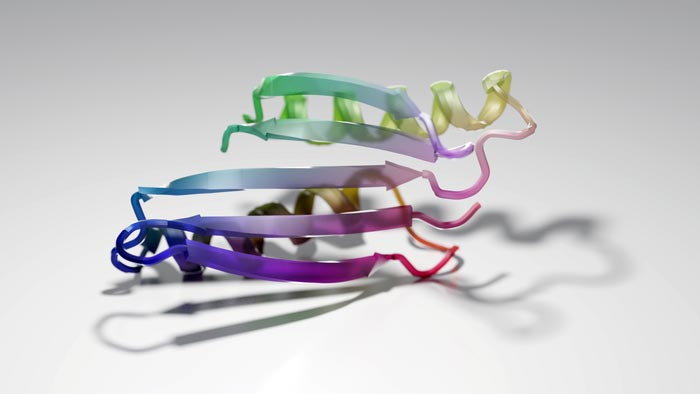Deep learning dreams up new protein structures

This twisting protein structure is one of hundreds dreamed up by a machine-learning algorithm
Credit: Ian C. Haydon/UW Medicine Institute for Protein Design
A neural network trained exclusively to predict protein shapes can also generate new ones.
Just as convincing images of cats can be created using artificial intelligence, new proteins can now be made using similar tools. In a report in Nature, researchers describe the development of a neural network that “hallucinates” proteins with new, stable structures.
Proteins, which are string-like molecules found in every cell, spontaneously fold into intricate three-dimensional shapes. These folded shapes are key to nearly every biological process, including cellular development, DNA repair, and metabolism. But the complexity of protein shapes makes them difficult to study. Biochemists often use computers to predict how protein strings, or sequences, might fold. In recent years, deep learning has revolutionized the accuracy of this work.
“For this project, we made up completely random protein sequences and introduced mutations into them until our neural network predicted that they would fold into stable structures,” said co-lead author Ivan Anishchenko, He is an acting instructor of biochemisty at the University of Washington School of Medicine and a researcher in David Baker’s laboratory at the UW Medicine Institute for Protein Design.
“At no point did we guide the software toward a particular outcome,“ Anishchenko said, “ These new proteins are just what a computer dreams up.”
In the future, the team believes it should be possible to steer the artificial intelligence so that it generates new proteins with useful features.
“We’d like to use deep learning to design proteins with function, including protein-based drugs, enzymes, you name it,” said co-lead author Sam Pellock, a postdoctoral scholar in the Baker lab.
The research team, which included scientists from UW Medicine, Harvard University, and Rensselaer Polytechnic Institute (RPI), generated two thousand new protein sequences that were predicted to fold. Over 100 of these were produced in the laboratory and studied. Detailed analysis on three such proteins confirmed that the shapes predicted by the computer were indeed realized in the lab.
“Our NMR [nuclear magnetic resonance] studies, along with X-ray crystal structures determined by the University of Washington team, demonstrate the remarkable accuracy of protein designs created by the hallucination approach”, said co-author Theresa Ramelot, a senior research scientist at RPI in Troy, New York.
Gaetano Montelione, a co-author and professor of chemistry and chemical biology at RPI, noted. “The hallucination approach builds on observations we made together with the Baker lab revealing that protein structure prediction with deep learning can be quite accurate even for a single protein sequence with no natural relatives. The potential to hallucinate brand new proteins that bind particular biomolecules or form desired enzymatic active sites is very exciting”.
“This approach greatly simplifies protein design,” said senior author David Baker, a professor of biochemistry at the UW School of Medicine who received a 2021 Breakthrough Prize in Life Sciences. “Before, to create a new protein with a particular shape, people first carefully studied related structures in nature to come up with a set of rules that were then applied in the design process. New sets of rules were needed for each new type of fold. Here, by using a deep-learning network that already captures general principles of protein structure, we eliminate the need for fold-specific rules and open up the possibility of focusing on just the functional parts of a protein directly.”
“Exploring how to best use this strategy for specific applications is now an active area of research, and this is where I expect the next breakthroughs,” said Baker.
Funding was provided by the National Science Foundation, National Institutes of Health, Department of Energy, Open Philanthropy, Eric and Wendy Schmidt by recommendation of the Schmidt Futures program, Audacious Project, Washington Research Foundation, Novo Nordisk Foundation, and Howard Hughes Medical Institute. The authors also acknowledge computing resources from the University of Washington and Rosetta@Home volunteers.
News release written by Ian C. Haydon, UW Medicine Institute for Protein Design.
Journal: Nature
DOI: 10.1038/s41586-021-04184-w
Method of Research: Computational simulation/modeling
Subject of Research: Not applicable
Article Title: De novo protein design by deep network hallucination
Article Publication Date: 1-Dec-2021
Media Contact
Leila Gray
University of Washington School of Medicine/UW Medicine
leilag@u.washington.edu
Cell: 206-475-9809
All latest news from the category: Life Sciences and Chemistry
Articles and reports from the Life Sciences and chemistry area deal with applied and basic research into modern biology, chemistry and human medicine.
Valuable information can be found on a range of life sciences fields including bacteriology, biochemistry, bionics, bioinformatics, biophysics, biotechnology, genetics, geobotany, human biology, marine biology, microbiology, molecular biology, cellular biology, zoology, bioinorganic chemistry, microchemistry and environmental chemistry.
Newest articles

Innovative 3D printed scaffolds offer new hope for bone healing
Researchers at the Institute for Bioengineering of Catalonia have developed novel 3D printed PLA-CaP scaffolds that promote blood vessel formation, ensuring better healing and regeneration of bone tissue. Bone is…

The surprising role of gut infection in Alzheimer’s disease
ASU- and Banner Alzheimer’s Institute-led study implicates link between a common virus and the disease, which travels from the gut to the brain and may be a target for antiviral…

Molecular gardening: New enzymes discovered for protein modification pruning
How deubiquitinases USP53 and USP54 cleave long polyubiquitin chains and how the former is linked to liver disease in children. Deubiquitinases (DUBs) are enzymes used by cells to trim protein…



